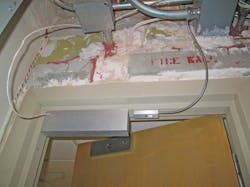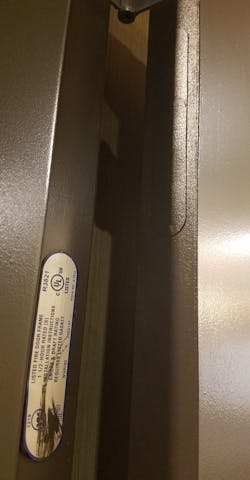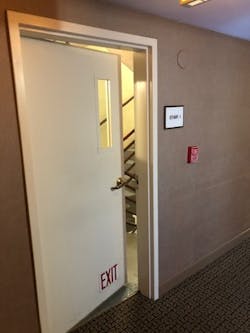13 Checkpoints to a Successful Fire-Door Inspection
A fire-door assembly (installed in a firewall) is used as part of a passive commercial fire-protection system to reduce the spread of fire or smoke between compartments and to enable safe egress. These openings must be inspected at different intervals according to the current code in place by the authority having jurisdiction (AHJ).
Organizations that govern these openings with applicable base codes include the International Code Council (ICC), National Fire Protection Association (NFPA) and American Society for Health Care Engineering (ASHE).
Fire-Door Inspectors
The building owner is responsible for maintaining and keeping fire-rated assemblies in working order. Fire-rated assembly inspections (NFPA 80-2022, 3.3.99) are to be performed by someone who has a degree, certificate, professional standing or skill and who has the knowledge, training and experience to deal with the subject matter, the work or the project.
Major components of a fire-rated assembly are the wall, frame, door and hardware, including closers, hinges, locks and bars, and all of which must be rated in accordance with the fire wall. For example, if a fire wall is rated for four hours, the frame, door and all hardware is rated one-quarter less, so, in this scenario for three hours. A two-hour-rated fire wall will have a 90-minute-rated frame, door and hardware.
Make sure you know the appropriate code year adopted for the fire-rated door under inspection as well as any amendments and written policies. These are the two overriding standards, although others might be involved:
NFPA 80 – Standard for Fire Doors and Other Opening Protectives (NFPA 101 7.2.1.15.2). The inspection of fire-rated doors and other protective openings and assemblies shall be inspected and tested in accordance with NFPA 80. This fire-door and opening protective standard defines the installation and maintenance requirements as well as allowances for field modification of fire doors. It also defines the annual inspection and testing requirements for fire doors and related hardware.
NFPA 105 – Standard for Smoke Door Assemblies and Other Opening Protectives. The standard for smoke-control doors defines the testing, labeling, installation and maintenance of doors required by the codes for smoke-control openings.
NFPA code books provide an annex that has additional information that isn’t part of the code but provides specific support criteria. One of the sections (A.5.2.2.4[10]) outlines specific functions that should be performed during a fire door inspection:
- Operation of the closing device, complete closure of the fire door
- Full engagement of latch(es) where required by door type
- Functional testing of automatic closing
- Functional power-operated fire-door assemblies
- Functional electrically controlled latching hardware or release devices, which might have to be coordinated with the facility during other electrically controlled system tests, such as fire-alarm-system testing through a licensed fire-alarm technician.
Fire-Door Inspection
Use these 13 points as a guide to shore up your fire-door inspections.
1. Labels are clearly visible and legible – Labels are critical components of a fire-rated assembly. They typically are attached to each door and the frame, and the labels provide evidence that the door size and exposed glass are permitted. However, some manufacturers stamp the frame instead of placing a label on the frame.
Missing or damaged labels, or labels painted over or otherwise compromised aren’t permissible. Labels that are embossed or have raised lettering are allowed to be painted. All locks and exit devices also must be fire-rated and include labels or stamp indicators.
Fire exit hardware is required to have a permanently attached label that has a serial number that shows the manufacturer’s name and type of approval. This label should differentiate between panic hardware, which isn’t acceptable for use on fire doors, and fire exit hardware. Field modifications, such as installing components that require additional cutting and mortising of the doors or frames must be conducted by individuals or companies that have been certified or listed as representatives of a labeling service.
2. No open holes or breaks exist in surfaces of either the door or frame – Periodic inspections, according to NFPA 80, include examining all hardware. Inoperative hardware, parts or other defective items must be replaced without delay. Damage on openings and small holes or occlusions can be sealed by using fire-rated caulk or steel screws, but these repairs must not be excessive. Be sure to use the right fire-rated substance to patch these areas. If repairs can be performed on a fire-rated assembly component, it must be “per manufacturer’s specification.”
3. Glazing, vision light frames and glazing beads are intact and securely fastened in place, if so equipped – No signs, notices or paperwork should be hung over any windows in a fire door, a common occurrence in schools and educational environments. Occupants have to see where they will exit and have no obstructions to the opening. Glass fire walls, which are rated to 180 minutes, are becoming increasingly popular and also must be inspected and include fire-rated labels.
5. No parts are missing or broken – Conduct a thorough inspection of the door and all its components, including the surface, hinges, hardware openers and closers. Functional operation of fire-door assemblies should include testing of the closing device, full engagement of latch(es) where required by the door type, any automatic closing and any power-operated fire-door assemblies. Testing of electrically controlled latching hardware or release devices might have to be coordinated with the facility.
6. Door clearances don’t exceed clearances listed in NFPA 80 Chapter 4 (4.8.4* and 6.3.1.7*) – Check for the door gap at the top and sides of the door. The clearances between the top and vertical edges of the door and the frame and the meeting edges of doors that swing in pairs, have to be one-eighth of an inch with one-sixteenths of an inch either way for steel doors and shouldn’t exceed one-eighths of an inch for wood doors.
7. The self-closing device is operational; that is, the door completely closes when operated from the fully open position – A minimum of two listed spring hinges are required on fire-rated doors. Magnetic hold-openers also may be present and must be tied into the fire-alarm system for release upon fire-system activation.
8. If a coordinator is installed, the inactive leaf closes before the active leaf – The purpose of a coordinator is to direct the two door leaves so they close in proper sequence — the inactive leaf before the active leaf. Check the operation of the two in tandem to ascertain their effectiveness in latching the door opening. (Coordinators are used only on pairs of doors, not on single doors.) Note: We recommend function testing on a coordinator on a quarterly basis.
9. Latching hardware operates and secures the door when in the closed position – Check how the door operates under normal circumstances and that it closes securely to prevent gaps or open areas where smoke and fire can penetrate.
10. Auxiliary hardware items that interfere or prohibit operation aren’t installed on the door or frame, such as stops or wedges – Any device or attempt to stop the complete operation of the fire-rated assembly isn’t permitted. Inspect for any attached or detached devices that prevent free operation. Although not permissible in commercial applications, certain group occupancies, dwellings and sleeping units may allow for locks and latches, according to IBC and NFPA 101. Other products such as concealed door closers, electric strikes, open back strikes, viewers or spring hinges are limited in use either by door and frame construction, size or maximum hourly protection.
Organizations that offer a labeling and listing service should indicate such limitations on the label or supplementary marking. The AHJ should refer to the individual manufacturer’s published listings when specific information is necessary. See A.4.6.3.1(a) through Figure A.4.6.3.1(i).
Fire-rated accessories must be positive pressure-tested per NFPA 252, and they should use UL 10C certified products. Common products include but aren’t limited to floor plates, door shoes, protective plates and other door hardware protective accessories. Fire pins also are more common, having been included in the NFPA 101, 2019 and IBC 2018 code series.
11. No field modifications to the door assembly have been performed that void the label – Protective accessories, such as seals, door closers, kick plates, power transfers and other hardware must be fire-rated. Surface-applied hardware should be installed on the door or frame without removing material other than drilling round holes to accommodate cylinders, spindles, similar operational elements and through bolts. The holes shall not be permitted to exceed a diameter of 1 inch, with the exception of cylinders.
The Annex also includes these guidelines for maintenance:
- Replacement of hardware components on swinging doors (hinges, pivots, door closers, etc.) isn’t considered to be a field modification when it doesn’t require additional cutting, mortising or boring into the doors and frames and the hardware meets the criteria specified in the standard. The installation of surface-mounted items, such as protection plates, isn’t considered to be field modifications.
- Cutting or enlarging doors for vision panels, and trimming doors in height or width are examples of field modifications. Similarly, installing components that require additional cutting and mortising of the doors or frames are field modifications.
In addition, a change in verbiage in NFPA 80 (4.1.3.2.3) now states the following: Holes that exceed a diameter of 1 inch shall be permitted for surface-applied hardware installed in accordance with the door and hardware manufacturer’s listings.
12. Meeting edge protection, gasketing and edge seals, where required, have been inspected to verify their presence and integrity – Check the overall integrity of the edge seals, which should be flexible, spongy and intact on the opening. Edge seals shouldn’t be painted over or otherwise altered.
13. Signage affixed to a door meets the listing requirements (4.1.4) – No extraneous information or signage is permitted on these openings. As people egress, they should get only what’s necessary to evacuate through the opening. Signs shouldn’t be installed on glazing material on fire doors. Informational signs are permitted to be installed on the surfaces of fire doors in accordance with 4.1.4.1 through 4.1.4.4 or in accordance with the manufacturer’s published listing.
This article should by no means be considered the complete requirements to conduct a fire-rated-assembly inspection. The appropriate NFPA 80 series year required per the local AHJ is your guideline for any inspection. For more information, visit ASSA ABLOY Door Security Solutions.
Rodger Schmidt, CAI, AFDI, an ASSA ABLOY technical product trainer, provides continuing education, technical training, webinars and other instruction to the electronic security hardware, door access and locking solutions industries. He can be reached at [email protected].






